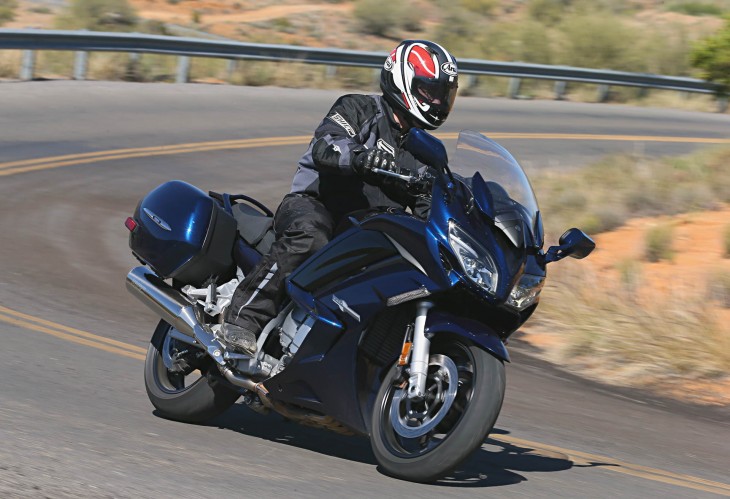
I just returned from testing the 2016 Yamaha FJR1300 models (both the A and the ES) in Arizona, and have the following report (both written and video). Before we get started with my riding impression, let’s review the specifications of the bike, particularly what is new for 2016.
Yamaha’s FJR1300 has been around in the same basic configuration since it was introduced back in 2003. That original FJR had a very modern engine design with plenty of displacement and torque, and Yamaha, rather than radically change the model, has focused on periodic refinement. The big 1298 cc inline four, for instance, gained more sophisticated features, including ride-by-wire throttle, adjustable engine maps, traction control and cruise control.
MD last tested the FJR1300 in 2013 when new styling and several of the electronic aides were first introduced. We were again impressed that the changes made by Yamaha effectively improved an already excellent sport tourer. Now, we have made our first evaluation of the changes for 2016. The following table summarizes the changes to both the 1300A and 1300ES:
If you have been following the development of the FJR1300, you know that it is one of the last, modern sport touring motorcycles to feature a five-speed transmission. In the past, both owners and journalists have typically said something like “This big, torquey engine only needs five speeds”, and that was true. But “needs” does not always equal “wants”, and the new six-speed transmission in the 2016 models make a big difference.
If you didn’t think your old FJR was buzzy or busy feeling at highway speeds, riding the 2016 FJR might change your mind. Sixth gear is 10% higher than last year’s fifth. It may not sound like much, but the drop in rpm levels at highway speeds makes the big FJR feel noticeably more relaxed … refined, even. Undoubtedly, lower rpms while cruising the highway will also improve fuel economy.
It isn’t just the new sixth gear, however, that makes a difference for 2016. The gear spacing in the lower gears feels much improved, as well. With an extra cog, the lower gears can be spaced more tightly — leaving the rider with the right gear for the right moment more often, and frequently with at least two gears available to do the job at hand. Additionally, Yamaha moved from straight cut to helical gears for 2016, significantly reducing “gear lash” — furthering the sense of refinement. For reference, here is some information on the gear spacing changes for 2016:
Also new for 2016 is the “Assist & Slipper Clutch”, which uses engine acceleration and deceleration forces to increase and decrease clutch engagement where appropriate. So in addition to the benefits of a slipper clutch (smoother corner entry, for instance), Yamaha was able to reduce the spring tension in the clutch basket to allow for an easier clutch pull (Yamaha claims 20% less effort).
Both models also receive new LED lighting for 2016, including headlight, taillight and turn signals. The 1300ES also receives three additional headlights that engage progressively as the bike leans into corners, illuminating through the corner. We discussed this feature in an earlier article. Since we have not ridden either model in the dark, we cannot comment on the effectiveness of this feature. We will test this when we get a test unit from Yamaha for a full ride review.
The FJR1300A has new suspension for 2016 from KYB, replacing the prior suspension manufacturer for this model. The fork is a very beefy 48mm, with full adjustability, while the shock is adjustable for rebound and spring preload. Of course, the new suspension units have different damping characteristics that we were able to test.
The instrument cluster has also been revised, and includes an anti-glare treatment. We found the legibility and contrast of the LED readouts excellent, even in bright daylight (a direct sun bounce off the face of the gauges is still a problem, but that is to be expected). Handlebar controls continue to allow the rider to adjust numerous features, including heated grip temperature, windshield height and, with the ES model, suspension settings that range from single rider with no luggage to rider and passenger with luggage. Deeper menus allow fine tuning of settings such as grip warmth and suspension damping levels. Indeed, there is so much adjustability it takes a bit of learning, but ultimately it is logical and easy to remember how to access different functions and make adjustments.
Other returning, standard features include a huge 6.6 gallon fuel tank ride-by-wire throttle with two selectable engine maps (including Sport and Touring), the aforementioned cruise control and traction control, ABS brakes (including, actuation of a single front brake caliper piston when using the rear brake pedal), the electronically adjustable windshield and 12 volt power outlet.
The saddlebags are standard, as well, and each of them will accommodate most large, full-face helmets (including my large Arai). The ergonomics are adjustable in that there are two seat heights available (20 mm range of adjustment) and the handlebars can be slid either 5 mm closer to, or further from, the rider.
We rode both models with the seat in the standard, taller position and the handlebars in the standard, central position. The reach to the ground was reasonable for my 5’11” frame (not completely flat footed, however), and the reach to the bars required a very slight forward lean (not quite bolt upright). The seat is firm and very supportive, and in general I found both FJRs very comfortable. A lengthy stint in the saddle, droning down the highway, did yield some discomfort. Some riders, particularly those who tour a lot, will benefit from an aftermarket seat, but most riders won’t bother changing it. The riding position itself felt close to perfect for long-distance touring.
Wind protection is excellent, and many riders will be able to dial in a windshield height that minimizes buffeting at the helmet level. Taller riders may keep the windshield in a lower position in order to provide smooth air flow at helmet level, however.
A relatively light throttle return spring and noticeably lighter clutch pull also help on longer rides, as does the standard cruise control that is very easy to engage and even fine tune (add or subtract 1 mph at a time) with a simple push of the left thumb. There are also air louvers in each of the side fairing panels that allow adjustment of air flow to the legs.
Throttle response and fuel injection mapping is nigh perfect (Sport mode is a bit snappier in its response, but still linear and predictable). The smooth throttle acts together with the reduced gear lash and slipper clutch to make riding, including aggressive riding, easy and more controllable. Whether opening the throttle on corner exits or quickly down-shifting on corner entries, the big FJR stays poised and balanced. Pretty impressive stuff.
Acceleration is strong in the lower gears and adequate at highway speeds in the overdrive sixth gear. If you are loafing along in sixth gear under 70 mph, a quick downshift might be necessary to pass, particularly two-up with luggage, but generally the bike has enough grunt to do the job even at rpm levels under 4,000. Just like any other inline four there is some vibration, perhaps most noticeable around 5,000 rpm (well above highway cruising speed in sixth). Vibration is well controlled, however, and it never became an issue or caused any significant discomfort during our test.
The new suspension on the 1300A worked extremely well. Smooth enough for touring, it was only slightly less plush than the electronic suspension on the ES (which absorbs small, choppy bumps superbly). More impressively, the non-electric suspension on the 1300A, particularly the fork, provided excellent feel and feedback that generated confidence while cornering and braking. The Bridgestone tires contributed here, as well, with good cornering grip and decent bump absorption compliance.
The brakes offered good power and feel, and the linking function (which engages a single front piston when the rear brake is applied) became invisible to me while riding at most speeds (normally, linked brakes annoy me because I have a particular corner entry technique with the rear brake). Initially, during stop-and-go riding in town, I felt even a light application of the rear brake resulted in a somewhat abrupt reaction from the front end (including mild brake dive). I stopped noticing this tendency, as well, after riding the bike a bit more.
Another “nanny” feature I didn’t care for, at first, involves Yamaha’s decision to add an additional 200 rpm as you let the clutch out from a stop. Intended by Yamaha to reduce stalling, initially an experienced rider will simply feel that he/she has lost exacting control of the throttle when leaving a stop. This sensation seemed to go away eventually, as well.
Both the 1300A and ES handle very well for their size (claimed wet weight in the neighborhood of 640 pounds). With the 6.6 gallon fuel tank freshly topped off, there is an increased sense of top heaviness, but generally both FJRs feel relatively compact and light for luxury sport tourers. Kawasaki’s Concours 14 weighs roughly 50 pounds more, by comparison, and has a slightly taller standard seat height.
With good leverage at the bars, the FJR can be hustled through the twisties without too much effort, and can even change directions relatively quickly. The video below might give you some sense of this fact. Mid-corner, the FJR is also stable and composed, and largely undisturbed by most bumps.
At higher speeds on the highway, the FJR is also very stable and composed … just as a long-distance tourer should be. With the excellent cruise control, comfortable rider triangle, well damped suspension and ample wind protection (including electrically adjustable windscreen that can stop anywhere within a generous 5.1″ range), the FJR is ready to ride as far as you might like. The fact that you can also enjoy a romp through a tight canyon road to break the monotony of the superslab adds to the return on your investment.
Based on our initial ride of both models, it appears Yamaha has again improved an excellent platform for riders that are looking for a luxury sport tourer. The FJR1300A is priced at an U.S. MSRP of $16,390, while the FJR1300ES is $17,990. Both models are available in the single Blue color pictured. The bikes are available now at U.S. dealers (although California models are not available until April). For additional details and specifications, visit Yamaha’s web site. You can also take a look at our video immediately below.
See more of MD’s great photography:
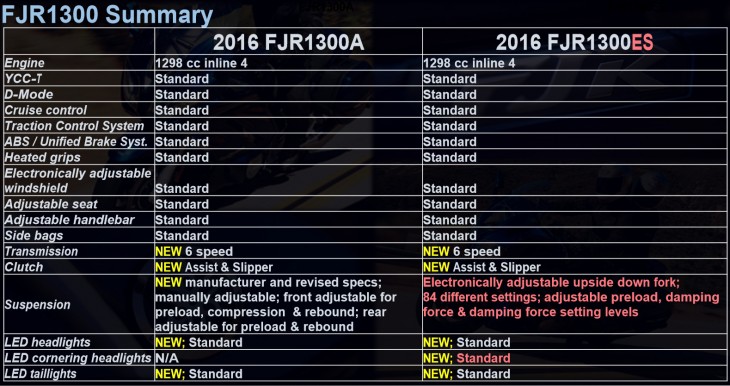
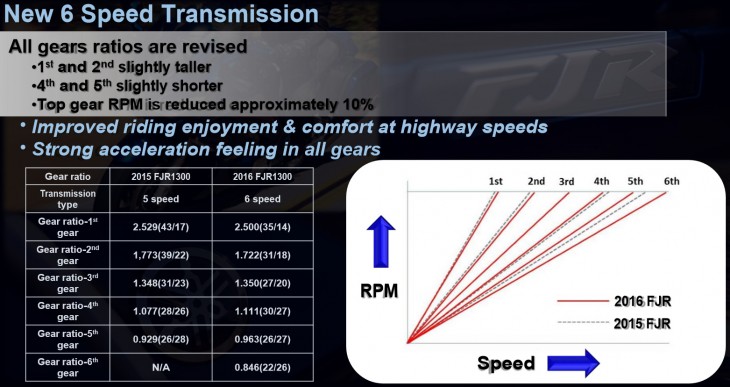
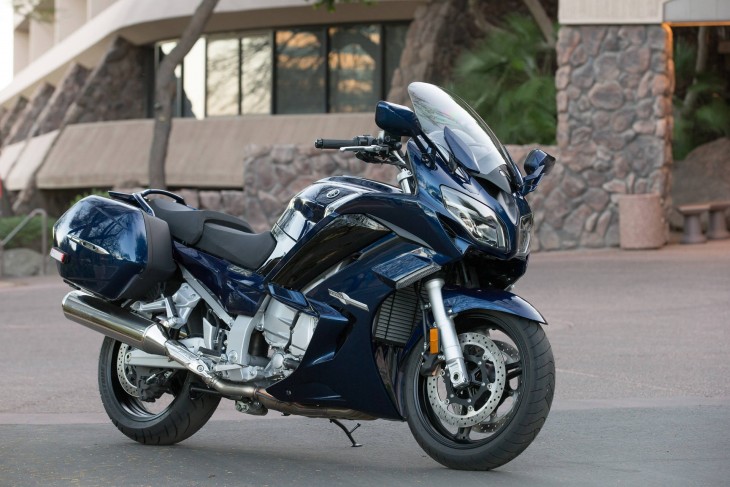

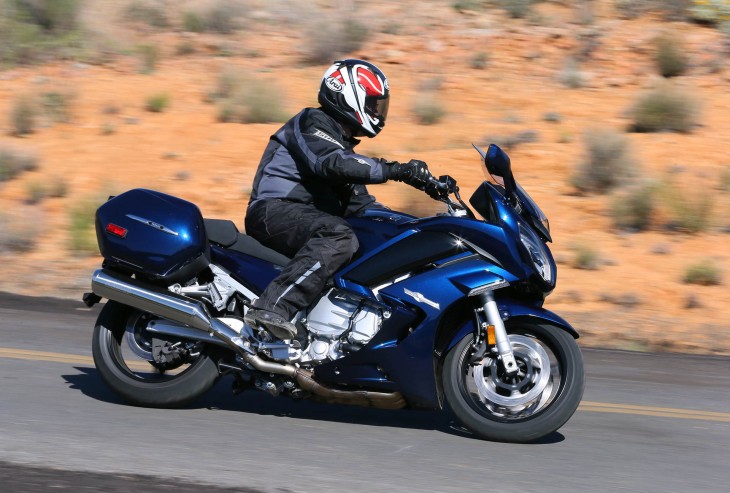
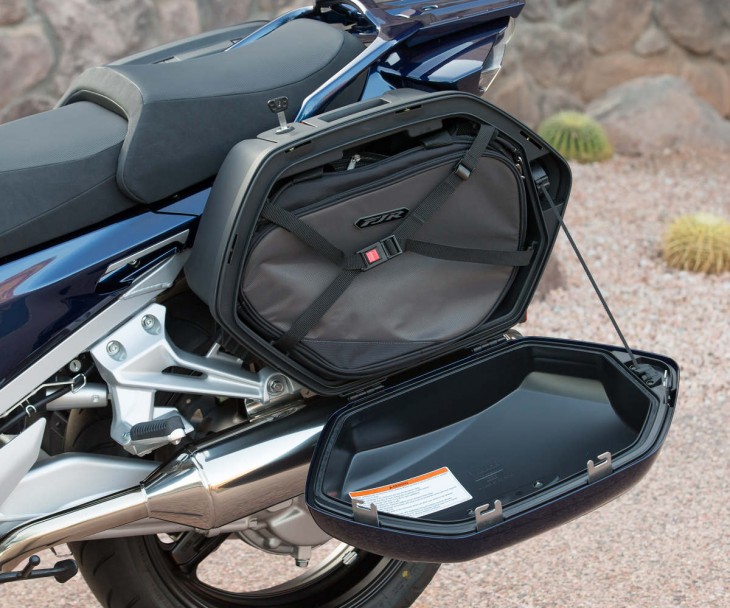
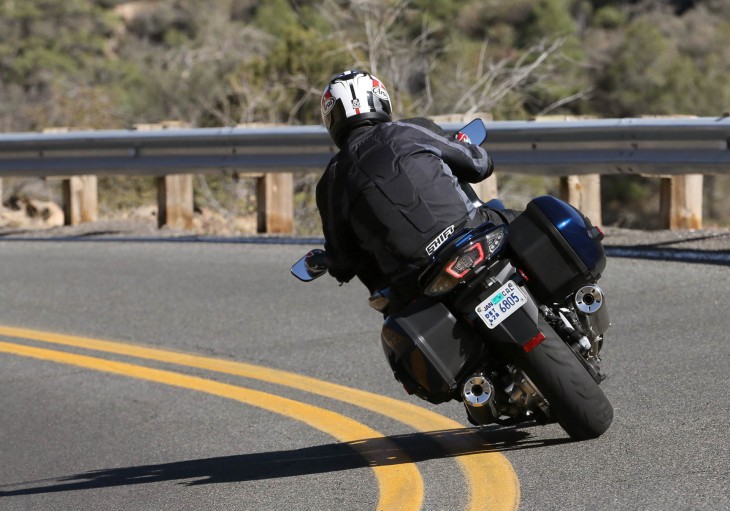






Last week, I completed a Portland, Oregon to Gainesville, Florida, cross country ride on a 2005 FJR1300. I had ridden it out there last summer (too hot) and parked it in a buddy’s garage. He was ready to have the space back and I needed a galavant.
The bike never hiccuped. Rode like a cadillac ( A CTS-V) down the PCH, West to East on HWY36, across Nevada…. Reno to Ely, over multiple mountain passes, Navajo country to 4 corners to Santa Fe, across Texas, into atrocious cross winds passing semi’s on I-40, ended up in heavy wet, windy weather in Louisiana, Mississippi, Alabama….what a ride.
Bought it a year ago for a good bit less than a 3rd of the cost of the new model with about 12k miles on it. Barely broken in. That 6th gear, LED headlights and new instruments is mighty costly. These bikes are super….and plentiful. I put a big Cee Baileys windshield on, highway pegs, a Givi top box and an I-phone charger (All for less than $1000). I’ve done two coast to coast rides now, expenses included, for about half of what it would cost to purchase a new model. People need to get out and ride…and quit worrying about tunable maps, electronic suspension, and cruise/traction controls. RIDE!
I really would love to own an FJR700
whoa!!! when did you start posting videos???
2011 but they have only done 1/2 dozen or so in that time. There is a link to videos in upper right hand corner above mast head.
Look good, but what about some naked version like the european xjr1300!
Not the same engine or chassis on the XJR13. It’s an air cooled decendant of the old FJ1200. Probably wouldn’t pass emission regs in California.
Maybe if they reduced it to 100 hp…
Oops. Did I say that?
Is the 5mm of handlebar adjustment correct? That is less than 1/4″ each way.. Hard to imagine you could feel much difference..
The Yamaha FJR1300 is an AWESOME motorcycle. Been riding them for almost 10 years now and I must say I have NEVER once thought to myself: “I need a 6th gear …” but that is what a large number of others owners (and potential buyers) have always requested for this bike so kudos to Yamaha for responding to market demand. I was not ready to spring an additional $3,000 to $4,000 for the 6th gear so I upgraded to new 2014 model (love the Red). The new “Generation III” features are indispensable and were long overdue (ride-by-wire throttle, cruise control system, two driving modes (sport and touring), and the integrated Traction Control System).
Yamaha could equip the FJ-09 with cruise, self cancelling and heated grips. Then it would be the good one.
And add a belt drive on the FJ-09, and it would be a winner over the big liter-plus rigs.
Also needed is a coffee machine in the right saddle bag and a dish washer in the other one.
Can’t have enough convenience items on these long distance battleships.
I guess it’s just me but, I consider the FJ-09 a liter bike.
847cc triple a “liter bike”? Mmmm, not in my book.
Somebody post the link to the video of the FJR1300 road tester waltzing off a pier when the side bag hit a post of some kind, causing him to fall about 10 feet down into the marina, the bike into a boat. “Hello, insurance company…”
I made a similar but much less dramatic error on my fat bike a couple days ago. I ride through an irrigation crick, where water flows during the summer but it’s dry from late fall to mid spring. I ducked my head down deep to clear a tree branch on the edge of the crick, forgetting my back pack sticks up above my back. The pack hit the branch and caused quite a startle, but I stayed upright. Hoping to remember to avoid that branch next time!
This would be that..
https://www.youtube.com/watch?v=Mb22mDaqSP4
Hard to watch, I was having my breakfast, had to turn away! 🙂
Wow, every time I try to post today I’m ending up in moderation. Woo-hoo… Good times.
Your turn in the barrel lol. i think yesterday was mine.
I’ve had some days where my posts would just go away. No matter how many times I tried or from which device it didn’t matter. Got so bad that I took to copying them before posting just so I didn’t have to try retyping them.
This bike has been on my short list of upright-seating-position bikes which could possibly replace my ’14 Street Triple R, the other two being the Triumph Bonneville T120 and the Honda CB1100. For me, remembering my Bandit 1200S and ST1300, both of which needed a sixth gear, the addition of the sixth cog to the big FJ for 2016 might make enough of a difference to swing me back to a Yamaha. (Haven’t owned a Tuning Fork motorcycle since my ’92 FJ1200, which I totaled a month after buying it. Come to think of it, I t-boned a deer and totaled the only other Yamaha I’ve ever ridden much on the street, my buddy’s Seca II 650. Man, I probably need to stay away from Yamahas!)
So, knowing my local BMW-Triumph-Ducati store happened to have a mint ’14 FJR1300 on hand, I made my way over there to check it out. Long story short, it’s just…too…big. Very fat tank, and quite heavy side-to-side. I don’t want something that huge, not for daily use. It’d be great for touring, but I don’t have the time to do multi-week rides.
Doubtless a great bike, but I’ll pass.
While I was there, though, whoa, there it was, the new T120, in the two-tone silver and red.
It was love at first sight. I was blown away by its sheer gorgeousness. Every little detail was just beautiful. It also fit me perfectly, and hardly any bike ever fits me perfectly.
Unfortunately that one was sold, and they had no others. I told the manager to give me a call the minute he has one ready to demo, and this store actually does demos. He says he should have a demo before the end of the month. I’ll see how the test ride goes, but as long as the fueling is decent and I don’t drag a peg simply from bending through the sweeper leading to the freeway, I think I’m grabbing one.
I’d really love to compare it to a CB1100 first, of course, but Honda doesn’t seem to want to cooperate, so I guess I’ll be sticking with Triumph for the time being, one way or the other.
Guess next week I’ll take a ride to the nearest Triumph dealer ( about 30 miles away) and take a gander at the Bonnie to see what you’re getting VLJ. If they don’t have one the next nearest dealer is about 75 miles away. Should be a good ride.
If you do make the trip, you have to bag a test ride on the T120. I know you’ll be heavily biased toward your Honda, which is understandable, but you gotta try to give me the most honest comparison possible.
The ultimate irony: I wish the Triumph had as much hp as a CB1100.
Seventy-nine crank hp scares me, but it does have more torque than the big Honda while weighing at least fifty pounds less. Coming from a Street Triple, riding something as low-revving as the CB or T120 will seem rather bizarre. My ST1300 wasn’t a rev monster either, but it made 113 rwhp, so there was always plenty of acceleration on hand.
With your bike and the T120, I’m not so sure. Low-end torque is nice, of course, but having the party end at 5,000 rpm will seem utterly alien to me.
Lol just relax and enjoy the ride.
I think I am fair when it comes to evaluating bikes and I like to ride all kinds. So if I am offered a ride on a T120 I would give it a fair report. Yesterday my dealer offered me a test ride on a CTX with DCT trans. I always wanted to ride a DCT trans bike. It was different for me but I can see where a new rider would love it.
Yes I love my CB, but along with 11 Hondas I have had 8 Yamahas, 3 Suzukis, 6 Harleys a Kawasaki, a Triumph and a BSA. So I am not adverse to other brands of bikes. Were I as rich as Jay Leno, I would have a garage very similar to his.
What you said about the weight is interesting, especially when your ST1300 weighed more (according to the spec sheets for both bikes). I used to have an ST1100 and always worried about the weight and size in heavy traffic, but it was a pussycat in the city. Very easy to filter. It made total sense as to why emergency services used them. Perhaps it has something to do with where the centre of gravity was in the FJR, rather than total weight?
No, you’re right, the ST1300 was huge, too. It was larger than the FJR1300. Were I to sit on one now, I’m certain I would have the same feeling I had when sitting on the FJR yesterday: great for touring, but too large and unwieldy for daily use.
I’m at the point where I tend to prefer small, light bikes with no windshields. I don’t even mind touring on them. I rode up to and across Canada on a naked SV650, with my wife riding pillion. It was fine. I have no problem riding my Street Triple R on five hundred-mile days. I like having clean air, no buffeting, a narrow tank, and easy, agile handling. I just need an upright seating position now.
The T120 isn’t light, but it’s much lighter than the CB1100, and a whole lot lighter than the massive FJR. It also sits more upright than the Honda or Yamaha. I suspect its handling won’t be all that agile, and I’m sure it won’t have anything like the top end rush I’m used to from having owned so many sport bikes, but we’ll see.
The jury is still out. I know I need to slow down on public roads, and I think the T120 is very beautiful, but I may not be able to live with the idea of a British equivalent to a Harley Sportster 1200. It may simply prove to be a bridge too far for me.
I agree with you there VLJ about the small light bike thing. I think the T120 is a good choice. Regarding their handling: it’s very good if you spend a bit extra on fixing the stock suspension. Some cartridge emulators and better rear shocks completely transform the bike.
I’m lucky enough to own a Kawasaki W800 nowadays and I’ve done the suspension upgrade + added Givi panniers. It’s much lighter than the ST1100 and just as capable (for my purposes) on the open road.
Very nice. Too big for my needs but, very nice.
I have always had a soft spot for this bike even though I have never owned one. Almost bought one 3 years ago but opted for the BMW K1300S which is 100 lbs lighter with substantially more HP and Torque. A decision that I have not regretted for a minute.
Back in the day I owned a 1992 FJ1200 briefly until I wrecked it in a tussle with a mazda RX7. It was a great bike, almost too refined however. My old GS1100 had less power, did not handle as well, however I found it more fun to ride. It had more personality than the Yamaha.
That is why I did not buy the FJR 1300. It comes across to me like the Nissan Murano of sport touring bikes. Mind you I would buy one over a Harley all day long.
The FJR is Always my dream bike. My personal preference for a sixth gear is that it be used for lazy long highway lugging at low RPM. I down shift to pass and climb.
Great video and review Dirck! Where about in Arizona was it filmed??
We rode back and forth between Phoenix and Sedona. Some nice roads.
Yamaha has some great details on this bike on their website. Take the color selection for example on the specifications tab, you can get it in Cobalt Blue and it is available AS SOON AS February 49st! I CAN’T WAIT!!
Yeah. That’s February in 49 states, and March in California. But way to stay vigilant. 👍
HAHAHA Thank you for explaining!
Again no mention of the pillions response. Why not? This is so important on this style of bike but you don’t bother!
They never do Pete. i’ve written Cycle, Rider, and RoadRunner in the past and asked them all to include pillion comments, but the truth is they just don’t think it relevant I guess. I suppose they think all men ride solo. My wife has been riding with me for for 44 years. Her opinion about her portion of the bike can kill a sale just as quickly as my opinion of my section.
Dirck did mention that this was just a press launch, and that later on he hopes to do a full road test. But if you’re reading this, Dirck…
Yes, it would be nice to know what a passenger says about this bike. I sold my ’03 FJR in part because my 5′ 10″ wife never got comfortable on the back. I’ve heard they’ve changed a lot of the things from the early models that should have fixed most of her complaints, but it would be great to hear some confirmation…
Rarely get the chance to carry a passenger at a press launch, but we will try to get some passenger feedback when we get our hands on a bike to test here in California.
settle down beavis
Very impressive – a true spiritual successor to the Honda ST1100/1300. Yamaha seems to be on a roll.
rode an 05 up and down the entire coast of california. besides burning my calves to a crisp, awesome all day long bike capable of anything.
One of the best bikes on the planet.
It is a pretty beast. I think the FJR is probably (and has always been) the most appealing of the big sport tourers. It has been over a decade since I last rode one, but I thought that engine was very impressive back then.
Weak on the top end compared to the Kawasaki or BMW, but lots of real world low end grunt. And of course Yamaha reliability which is why this bike is the bike of choice in the iron butt community.
Even though this video was brief, I sure wish MD would produce more coming up.
Not sure why my previous comment got binned. I want one of these, with the improvements Yamaha has introduced this year. Don’t know if I can justify spending the money, though – over CDN$20,000 with taxes. This is my idea of a true sport-touring bike – capable of cruising long distances on the freeway if necessary, and yet still enjoyable in the twisties, as long as they aren’t too tight. I had an original Concours some years ago and I still miss that kind of ability. My current bike is more fun in sporting mode, but not fun to ride for 8-10 hours a day.
Beautiful sport tourer. Yamaha has worked hard over the years to keep it relavent in the Sport Touring world, unlike Honda who let the ST 1300 languish and die a slow death. I wonder how many the sell of these a year?
Too bad about the ST1300. That was (still is) a nice bike. I don’t see why Honda couldn’t play the same card as Yamaha and just gradually improve that base package over the years. Maybe the VFR1200 was supposed to supersede it, but that bike didn’t resonate well with its intended market.
I know. Its sad. Love my ST, but if Honda just would have updated with maybe a 6 th gear, cruise control, some better suspension, maybe a digital gear read out in the last 13 years it would still be competitive. Instead nada.
I always wished my ST1300 had had a sixth gear, for sure. My other two gripes were that it gave off way too much engine heat, and I never did find a happy spot with the windscreen, in terms of eliminating the noisy buffeting. It wasn’t as bad as my V-Strom 1000’s buffeting, but it was definitely a problem.
I had the first year (2003) model—in fact, the first ST1300 sold in NoCal—so it hadn’t yet received the heat-shield fix Honda implemented in 2004 (IIRC). Mine was so hot that I chose not to take it on a summer vacation trek to Utah, which spelled the end of my ownership of that bike.
Oddly, I think I preferred my ST1100 to my ST1300. I know I kept it much longer.
Yes VLY, your comments are spot on with me, my ST13 was an expensive Dec 2003 purchase. Resale 6 months later was a very significant loss as the word of how bad they were had passed around here in Australia.
That buffeting was the big killer for me. Even the State Police rejected them then in favour of Yamaha FJ13’s & BMW’s.
The CTX1300 till it’s killed off, is the ST13 successor. Another unpopular Honda in Australia too.
The VFR1200F and the X variant where to have another one called the VFR1200T, but Honda killed that off in GFC meltdown. That’s why the other two have shaft drive as the T (for Tourer) was to be the money spinner and amortise the costs across 3 variant’s of the VFR series.
My 2015 VFR1200F is another Honda that was ill conceived ergonomic design because of the T’s need to be stretched lengthwise, but that’s another story.
The ST1100 was another one of those vehicles from Japan’s “perfection” era. Like the first Lexus LS and SC, The NSX, the Miata, the 900RR, and virtually the entire 600 class of bikes. Up until then, things genuinely and fundamentally improved at a rapid pace. Afterwards, the newer designs have been different, but not really any better at the task of performing the tasks they were designed to do.